Grace Elliot's Blog: 'Familiar Felines.' , page 4
September 29, 2015
Deadly Cat Customs
It is relatively recently that cats have shed their sinister associations to become a much loved, benign pet and family member. In previous centuries the cat was viewed with suspicion or even regarded as the Devil's agent.
"Among quadrupeds the cat has long been looked upon with suspicion, a circumstance due no doubt to the belief that this was one of the forms in which witches were wont to masquerade." Corrie 1890/1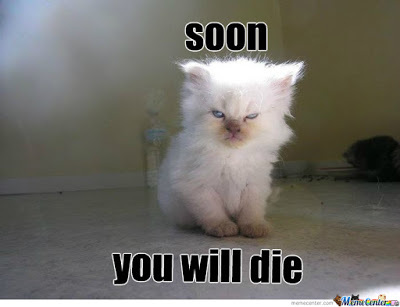
This goes some way to explain why there are so many superstitions linking cats and death. Indeed our first custom relates to cat predicting death. It was said if a cat refused to come into the house where a sick person lay, this was a predictor of the later's impending departure from this earth. This ability was said to be due to the cat's ability to see beyond the physical world and tap into the supernatural.
"Mrs Fawset's cat had been curled asleep on the rug...he started up, eyes glaring, fur on end and made fantic efforts to get out of the room...We later learnt this was the exact time that Mrs Fawset died."22 Nov 1930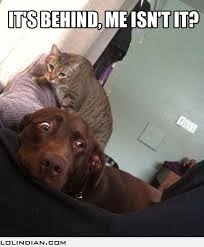
Conversely, in previous centuries if a member of the household died, then the cat was banned from the house. This stems from a belief that if the cat jumped over the body or coffin, the welfare of the deceased spirt would be imperiled.
"It was not uncommon for the cat to be imprisoned beneath an inverted tub." Wood 1911
This fear even extended to the funeral cortege, with widespread panic is a cat was spotted strolling near the church.

Turning things on their head, the is a traditional saying: "Curiosity killed the cat." Playwright Ben Jonson used a similar phrase in his 1598 play, Every Man in his Humour.
"Helter skelter, hang sorrow, care will kill a cat, up-tails all, and a pox on the hangman."
Shakespeare used a similar version of this saying in Much Ado About Nothing (1599)"What, courage man! What though care killed a cat, though has mettle enough in thee to kill care."
So when did curiosity put in an appearance?
The earliest written record of "Curiosity killed the cat" was in a compendium published in 1873, where it was listed an an Irish proverb, and it makes more sense to me than "Care killed the cat."
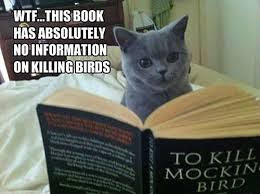
***New Release!
Castles, Customs, and Kings: True Tales by English Historical Fiction Authors, Volume 2
Edited by Debra Brown and Sue MillardContributing author: Grace Elliot
An anthology of essays from the second year of the English Historical Fiction Authors blog, this book transports the reader across the centuries from prehistoric to twentieth century Britain. Nearly fifty different authors share the stories, incidents, and insights discovered while doing research for their own historical novels.
From medieval law and literature to Tudor queens and courtiers, from Stuart royals and rebels to Regency soldiers and social calls, experience the panorama of Britain’s yesteryear. Explore the history behind the fiction, and discover the true tales surrounding Britain’s castles, customs, and kings.
Purchase links:
Amazon US http://www.amazon.com/Castles-Customs...
Amazon UK http://www.amazon.co.uk/Castles-Custo...
"Among quadrupeds the cat has long been looked upon with suspicion, a circumstance due no doubt to the belief that this was one of the forms in which witches were wont to masquerade." Corrie 1890/1

This goes some way to explain why there are so many superstitions linking cats and death. Indeed our first custom relates to cat predicting death. It was said if a cat refused to come into the house where a sick person lay, this was a predictor of the later's impending departure from this earth. This ability was said to be due to the cat's ability to see beyond the physical world and tap into the supernatural.
"Mrs Fawset's cat had been curled asleep on the rug...he started up, eyes glaring, fur on end and made fantic efforts to get out of the room...We later learnt this was the exact time that Mrs Fawset died."22 Nov 1930

Conversely, in previous centuries if a member of the household died, then the cat was banned from the house. This stems from a belief that if the cat jumped over the body or coffin, the welfare of the deceased spirt would be imperiled.
"It was not uncommon for the cat to be imprisoned beneath an inverted tub." Wood 1911
This fear even extended to the funeral cortege, with widespread panic is a cat was spotted strolling near the church.

Turning things on their head, the is a traditional saying: "Curiosity killed the cat." Playwright Ben Jonson used a similar phrase in his 1598 play, Every Man in his Humour.
"Helter skelter, hang sorrow, care will kill a cat, up-tails all, and a pox on the hangman."
Shakespeare used a similar version of this saying in Much Ado About Nothing (1599)"What, courage man! What though care killed a cat, though has mettle enough in thee to kill care."
So when did curiosity put in an appearance?
The earliest written record of "Curiosity killed the cat" was in a compendium published in 1873, where it was listed an an Irish proverb, and it makes more sense to me than "Care killed the cat."

***New Release!
Castles, Customs, and Kings: True Tales by English Historical Fiction Authors, Volume 2
Edited by Debra Brown and Sue MillardContributing author: Grace Elliot
An anthology of essays from the second year of the English Historical Fiction Authors blog, this book transports the reader across the centuries from prehistoric to twentieth century Britain. Nearly fifty different authors share the stories, incidents, and insights discovered while doing research for their own historical novels.
From medieval law and literature to Tudor queens and courtiers, from Stuart royals and rebels to Regency soldiers and social calls, experience the panorama of Britain’s yesteryear. Explore the history behind the fiction, and discover the true tales surrounding Britain’s castles, customs, and kings.
Purchase links:
Amazon US http://www.amazon.com/Castles-Customs...
Amazon UK http://www.amazon.co.uk/Castles-Custo...
Published on September 29, 2015 13:11
September 27, 2015
Popular Feline Sayings and their Origins
Expressions such as ‘Letting the cat out of the bag’, and ‘A cat in hell’s chance’ are in common parlance – yet what are their origins?
If you stop to think about it, putting a cat in a bag in the first place is a strange thing to do. So that you don't lose sleep over this, let’s take a look at the origins of these popular sayings.
Let the Cat Out of the BagThis expression means to give away a secret. As a child I remember my parents using this expression, and feeling vaguely perplexed that a cat was in a bag in the first place. Why was it there? Who put it there? Although in my childish mind I knew with all certainty that the cat was ginger(I’ve no idea why). It’s origins go back to 18th century tricksters selling goods in the market. The trader claimed to be selling piglets and presented the punter with a wriggling bag. If the potential purchaser asked to see inside, the tradesmen would tell them the pig was too lively and to open the bag risked it escaping. If the purchaser insisted, then the bag was opened and an irate cat jumped out – hence giving away the fraudster’s secret trick.
An interesting twist is another saying, “Never buy a pig in a poke” comes from the same source. This is a warning about buying unseen goods, with the ‘poke’ in question being another word for the bag or sack.
Raining Cats and DogsThis popular expression meaning a deluge or exceptionally heavy rain, has less than pleasant origins. It goes back centuries to when towns were basically roads lined with houses with very little in the way of drainage. In addition, there were lots of stray animals who were often in a pitiful state of health. After a heavy downpour the rainwater flowed in makeshift rivers through the streets, sweeping refuse ahead of it.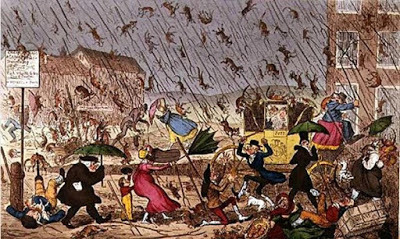
When people emerged from their houses they often found the corpses of these unfortunate strays, washed up in the gutter. This gave the impression that the cats and dogs had actually fallen from the skies along with the rain, and hence gave rise to this expression. It must have been a deeply unpleasant scene, as in this description of a storm by Jonathan Swift, written in1710. “Now from all parts the swelling kennels [gutters] flow, and bear their trophies with them as they go…drowned puppies, stinking sprats, all drenched in mud, dead cats, and turnip tops, come bumbling down the flood.”
A Cat-in-Hell’s ChanceThis saying means that a successful outcome is very unlikely. Although the expression is well known its origins are murky and uncertain. A likely explanation may be found in the longer version: “No more chance than a cat in hell without claws” – meaning ot be pitted against impossible odds without adequate means to defend oneself.
Indeed, as another saying goes: “He that plays with cats, must expect to be scratched.” 1710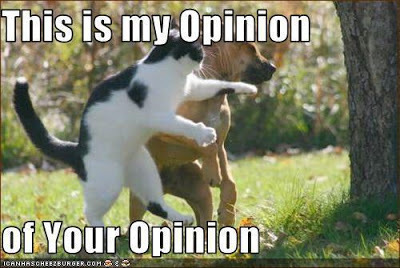
If you stop to think about it, putting a cat in a bag in the first place is a strange thing to do. So that you don't lose sleep over this, let’s take a look at the origins of these popular sayings.

Let the Cat Out of the BagThis expression means to give away a secret. As a child I remember my parents using this expression, and feeling vaguely perplexed that a cat was in a bag in the first place. Why was it there? Who put it there? Although in my childish mind I knew with all certainty that the cat was ginger(I’ve no idea why). It’s origins go back to 18th century tricksters selling goods in the market. The trader claimed to be selling piglets and presented the punter with a wriggling bag. If the potential purchaser asked to see inside, the tradesmen would tell them the pig was too lively and to open the bag risked it escaping. If the purchaser insisted, then the bag was opened and an irate cat jumped out – hence giving away the fraudster’s secret trick.

An interesting twist is another saying, “Never buy a pig in a poke” comes from the same source. This is a warning about buying unseen goods, with the ‘poke’ in question being another word for the bag or sack.
Raining Cats and DogsThis popular expression meaning a deluge or exceptionally heavy rain, has less than pleasant origins. It goes back centuries to when towns were basically roads lined with houses with very little in the way of drainage. In addition, there were lots of stray animals who were often in a pitiful state of health. After a heavy downpour the rainwater flowed in makeshift rivers through the streets, sweeping refuse ahead of it.

When people emerged from their houses they often found the corpses of these unfortunate strays, washed up in the gutter. This gave the impression that the cats and dogs had actually fallen from the skies along with the rain, and hence gave rise to this expression. It must have been a deeply unpleasant scene, as in this description of a storm by Jonathan Swift, written in1710. “Now from all parts the swelling kennels [gutters] flow, and bear their trophies with them as they go…drowned puppies, stinking sprats, all drenched in mud, dead cats, and turnip tops, come bumbling down the flood.”
A Cat-in-Hell’s ChanceThis saying means that a successful outcome is very unlikely. Although the expression is well known its origins are murky and uncertain. A likely explanation may be found in the longer version: “No more chance than a cat in hell without claws” – meaning ot be pitted against impossible odds without adequate means to defend oneself.
Indeed, as another saying goes: “He that plays with cats, must expect to be scratched.” 1710

Published on September 27, 2015 12:18
September 13, 2015
Some Favorite Cat Memes
Many apologies, but for reasons too complex to go into, I'm running way behind this week. Rather than leave a blank space (cue for a Taylor Swift song?) I've posted a few of my favorite cat memes to make you smile.
Normal service will be resumed in two weeks time.
Grace xxx
There's this one...
 and this aspirational cat meme...
and this aspirational cat meme...
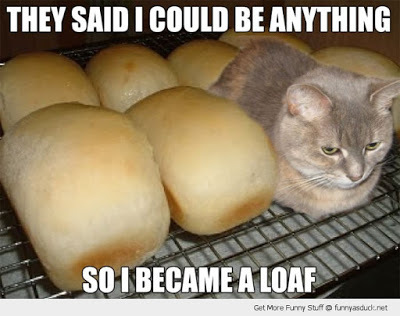 and sinister is always funny - especially when the cat comes off best
and sinister is always funny - especially when the cat comes off best
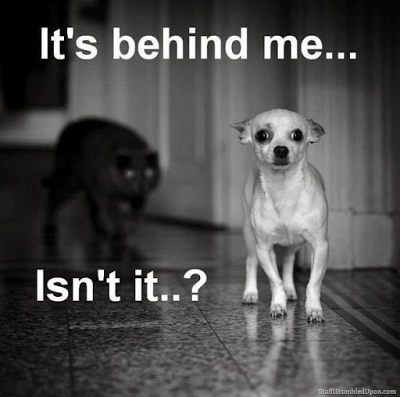 Then there's the way cats have life so sorted...
Then there's the way cats have life so sorted...
 and this one reminds me of Widget - only in her case she wanted to taste the guinea pig food...
and this one reminds me of Widget - only in her case she wanted to taste the guinea pig food...
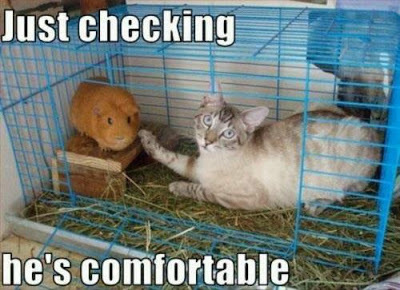 Then there are the cats that comment on the state of society
Then there are the cats that comment on the state of society
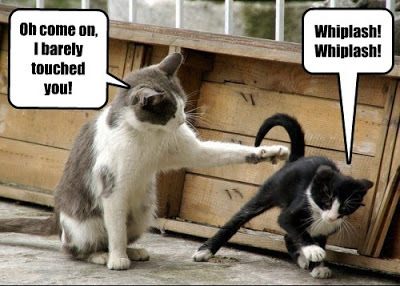 and the cats with a keen sense of observation
and the cats with a keen sense of observation
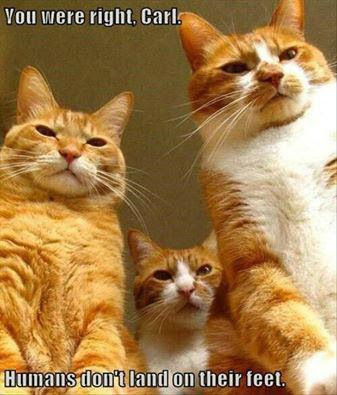 and not forgetting their sense of irony...
and not forgetting their sense of irony...
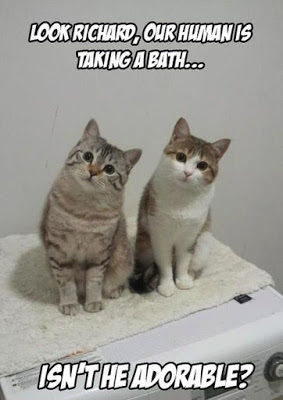 their unrivaled cuteness
their unrivaled cuteness
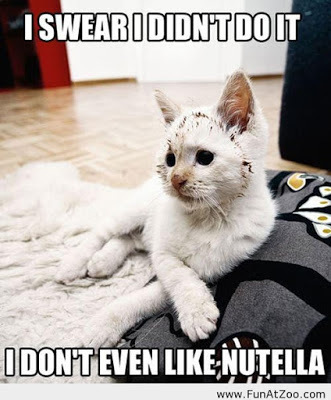 and this...
and this...
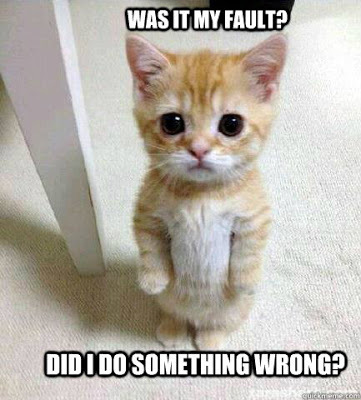 That's quite a lot of favorites isn't it....and I haven't even scratched the surface.
That's quite a lot of favorites isn't it....and I haven't even scratched the surface.
Night all,
sleep well.
G x
Normal service will be resumed in two weeks time.
Grace xxx
There's this one...
 and this aspirational cat meme...
and this aspirational cat meme... and sinister is always funny - especially when the cat comes off best
and sinister is always funny - especially when the cat comes off best Then there's the way cats have life so sorted...
Then there's the way cats have life so sorted... and this one reminds me of Widget - only in her case she wanted to taste the guinea pig food...
and this one reminds me of Widget - only in her case she wanted to taste the guinea pig food... Then there are the cats that comment on the state of society
Then there are the cats that comment on the state of society and the cats with a keen sense of observation
and the cats with a keen sense of observation and not forgetting their sense of irony...
and not forgetting their sense of irony... their unrivaled cuteness
their unrivaled cuteness and this...
and this... That's quite a lot of favorites isn't it....and I haven't even scratched the surface.
That's quite a lot of favorites isn't it....and I haven't even scratched the surface.Night all,
sleep well.
G x
Published on September 13, 2015 13:13
September 6, 2015
Portaloos and Puppies: Reflections on the Popularity of Spaniels
Yesterday I spent the day sitting in a field in the freezing cold, listening to various lectures on topics such as 'neuropathic pain' and 'cranial nerve examination'. This was part of my undertaking as a veterinarian to keep to date with developments in veterinary science. The event was called "Vet Festival" but what I had failed to appreciate before setting off was "Festival" was as in an outdoor music event rather than meaning a celebration. Hence the portaloos, tents, and me being desperately under-dressed in sandals!

However it was all worthwhile because the lectures were excellent and very practical. Also, the organizer, Noel Fitzpatrick, wanted to emphasize / rekindle a love for animals - which he very much did. This set me thinking about pet keeping over the centuries, and hence the topic for this week's blog post - a royal loves of spaniels!
The history linking England’s monarchs to spaniel breeds goes back centuries. In the 16th century Henry VIII decreed that only “some small spanyells for the ladies”would be allowed at court, and the spaniels were described as “smalle ladyes puppees”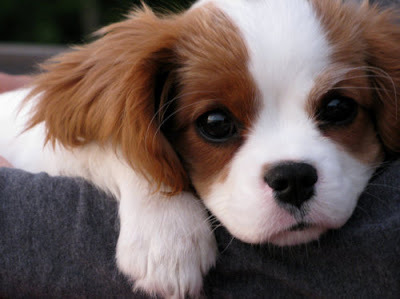
Perhaps the king most associated with dogs was Charles II. He owned so many spaniels that his Gentleman of the Bedchamber, the Earl of Ailesbury [sic], used them as a metaphor for currying-favour, describing certain courtiers as: “Pliant as a spaniel dog.” The dogs Charles prefered are today known as King Charles Spaniels – a name which was never applied to them in their day. These dogs were much beloved of King Charles I – and folk lore has it that every dog across the land wept when at Charles I’s execution.
A subtly different strain of spaniel was favoured by Charles II – and became known as the ‘Cavalier’ King Charles Spaniel – a term synonymously linked to the Royalist cause and therefore potentially dangerous to own during the Civil War. With the eventual restoration of the monarch in 1660, in celebration the new king was said to award Cavalier spaniels the freedom of every inn in the land, that they were not to be denied access to any public place and they alone were allowed the freedom to roam the royal parks!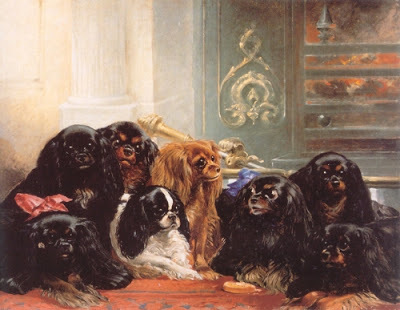
Indeed Samuel Pepys accompanied Charles aboard the Naseby, in 1660, on his return to England. He records the presence of a dog: “That the King loved, which sh*t in the boat, which made us laugh and me think that a King and all that belong to him are but just as others are.”
In the 18thcentury and the Hanovarians now on the throne, spaniels were well established as part of court life, and regularly featured in portraits of royal children. Indeed, in the early 19th century the Prince Regent commissioned a portrait of his father, George III, with a spaniel at his feet and a statue of Charles II in the background. By 1841 it was estimated that five thousand spaniels were kept as pets in London alone, but it was to be over a hundred years later, in 1945 that the breed was first officially recognised as Cavalier King Charles Spaniel.
In the early 18thcentury, the Duke of Marlborough, John Churchill, kept red and white coloured King Charles spaniels, which he records as trotting alongside his horse. His estate was named Blenheim, after the Battle of Blenheim, and as a patron of the red and white spaniel, this colour variety of King Charles and Cavalier King Charles became called Blenheim.
Now of course spaniels are much loved companions for all dogs lovers, although their popularity has meant in-breeding has produced conditions such as Chiari-like malformation, syringomyelia and a propensity to heart disease, which are excrutiatingly painful (the former - as show in the lectures yesterday) and heart-breaking (the later.) Hence sometimes being popular is not always a good thing.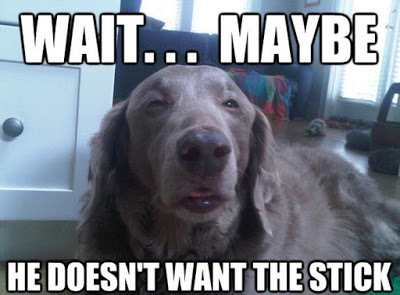

However it was all worthwhile because the lectures were excellent and very practical. Also, the organizer, Noel Fitzpatrick, wanted to emphasize / rekindle a love for animals - which he very much did. This set me thinking about pet keeping over the centuries, and hence the topic for this week's blog post - a royal loves of spaniels!
The history linking England’s monarchs to spaniel breeds goes back centuries. In the 16th century Henry VIII decreed that only “some small spanyells for the ladies”would be allowed at court, and the spaniels were described as “smalle ladyes puppees”

Perhaps the king most associated with dogs was Charles II. He owned so many spaniels that his Gentleman of the Bedchamber, the Earl of Ailesbury [sic], used them as a metaphor for currying-favour, describing certain courtiers as: “Pliant as a spaniel dog.” The dogs Charles prefered are today known as King Charles Spaniels – a name which was never applied to them in their day. These dogs were much beloved of King Charles I – and folk lore has it that every dog across the land wept when at Charles I’s execution.
A subtly different strain of spaniel was favoured by Charles II – and became known as the ‘Cavalier’ King Charles Spaniel – a term synonymously linked to the Royalist cause and therefore potentially dangerous to own during the Civil War. With the eventual restoration of the monarch in 1660, in celebration the new king was said to award Cavalier spaniels the freedom of every inn in the land, that they were not to be denied access to any public place and they alone were allowed the freedom to roam the royal parks!

Indeed Samuel Pepys accompanied Charles aboard the Naseby, in 1660, on his return to England. He records the presence of a dog: “That the King loved, which sh*t in the boat, which made us laugh and me think that a King and all that belong to him are but just as others are.”
In the 18thcentury and the Hanovarians now on the throne, spaniels were well established as part of court life, and regularly featured in portraits of royal children. Indeed, in the early 19th century the Prince Regent commissioned a portrait of his father, George III, with a spaniel at his feet and a statue of Charles II in the background. By 1841 it was estimated that five thousand spaniels were kept as pets in London alone, but it was to be over a hundred years later, in 1945 that the breed was first officially recognised as Cavalier King Charles Spaniel.

In the early 18thcentury, the Duke of Marlborough, John Churchill, kept red and white coloured King Charles spaniels, which he records as trotting alongside his horse. His estate was named Blenheim, after the Battle of Blenheim, and as a patron of the red and white spaniel, this colour variety of King Charles and Cavalier King Charles became called Blenheim.

Now of course spaniels are much loved companions for all dogs lovers, although their popularity has meant in-breeding has produced conditions such as Chiari-like malformation, syringomyelia and a propensity to heart disease, which are excrutiatingly painful (the former - as show in the lectures yesterday) and heart-breaking (the later.) Hence sometimes being popular is not always a good thing.

Published on September 06, 2015 02:37
August 30, 2015
Cats in Fiction: Some Musings
Is it just me, or is a house not a home without a pet?
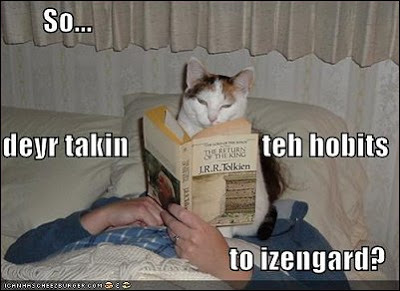
OK, I admit to being biased because I’m a bit bonkers when it comes to cats, but for me animals give a place soul – and the same is so for animals in books – their presence gives an extra dimension and by seeing how characters react to felines, give extra clues to their character. References to cats in particular can be found in classic literature from Charles Dickens to Henry James, Rudyard Kipling to Emile Zola.
Indeed, I suspect the Victorian novelist George Moore thinks much the same as me as he bemoaned the absence of pets from those most august of novels ‘Tom Jones’ and ‘Vanity Fair’. His reasoning went like this:“Both books lack intimacy of thought and feeling. No one sits by the fire and thinks…and welcomes the approach of a familiar bird or animal.”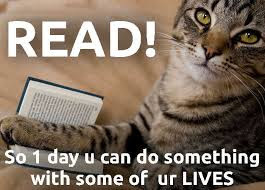
To my view, Charles Dickens was on the right track. He knew that animals are important in making a book come to life. Take for example ‘Bleak House’ which features several cats. There is Krook’s cat Lady Jane who follows her master or perches hissing on his shoulder. Then there is Mr Jellyby’s cat who finishes his morning milk, and finally, Mrs Pipchin’s old cat who likes to purr... “While the contracting pupils of his eyes looked like two notes of admiration.”
Come to think of it, Dickens has quite an association with cats because he made several references to cat pies…but that’s another story.
Perhaps the master of feline literature is Rudyard Kipling in his “Just So”stories. He wrote a story titled “The cat that walked by himself”. In this tale the cat makes a bargain with the woman that he will accept milk and a place by the hearth, and in return will do only what he wants to do– which deliciously sums up the independent nature of the cats.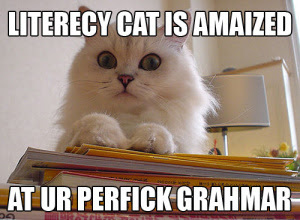
In one of my favorite novels, ‘Wolf Hall’ by Hilary Mantel, there is a delicious evocative passage that describing an interaction with Cromwell’s cat, Marlinspike.
“A cat may look at a king,” he [Cromwell] says. He is cradling Marlinspike in his arms, and talking to Thomas Avery, the boy he’s teaching his trade……He puts the cat down, opens the bag. He fishes up on a finger a string of rosary beads; for show says Avery, and he says, good boy. Marlinspike leaps on to his desk; he peers into the bag, dabbing with a paw. “The only mice in there are sugar ones.” The boy [Avery] pulls the cat’s ears, tussles with him. “We don’t have any little pets in Master Vaughan’s house.”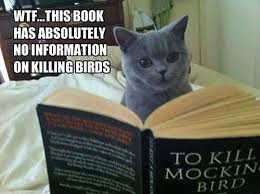
I love to find a reference to an animal in a novel. To see how characters react to it can speak volumes for their personality – things they may wish to keep hidden, leak to the surface when there’s a cat about. Do you have a favorite fictional cat? If so, do leave a comment and share the love.

OK, I admit to being biased because I’m a bit bonkers when it comes to cats, but for me animals give a place soul – and the same is so for animals in books – their presence gives an extra dimension and by seeing how characters react to felines, give extra clues to their character. References to cats in particular can be found in classic literature from Charles Dickens to Henry James, Rudyard Kipling to Emile Zola.
Indeed, I suspect the Victorian novelist George Moore thinks much the same as me as he bemoaned the absence of pets from those most august of novels ‘Tom Jones’ and ‘Vanity Fair’. His reasoning went like this:“Both books lack intimacy of thought and feeling. No one sits by the fire and thinks…and welcomes the approach of a familiar bird or animal.”

To my view, Charles Dickens was on the right track. He knew that animals are important in making a book come to life. Take for example ‘Bleak House’ which features several cats. There is Krook’s cat Lady Jane who follows her master or perches hissing on his shoulder. Then there is Mr Jellyby’s cat who finishes his morning milk, and finally, Mrs Pipchin’s old cat who likes to purr... “While the contracting pupils of his eyes looked like two notes of admiration.”
Come to think of it, Dickens has quite an association with cats because he made several references to cat pies…but that’s another story.
Perhaps the master of feline literature is Rudyard Kipling in his “Just So”stories. He wrote a story titled “The cat that walked by himself”. In this tale the cat makes a bargain with the woman that he will accept milk and a place by the hearth, and in return will do only what he wants to do– which deliciously sums up the independent nature of the cats.

In one of my favorite novels, ‘Wolf Hall’ by Hilary Mantel, there is a delicious evocative passage that describing an interaction with Cromwell’s cat, Marlinspike.
“A cat may look at a king,” he [Cromwell] says. He is cradling Marlinspike in his arms, and talking to Thomas Avery, the boy he’s teaching his trade……He puts the cat down, opens the bag. He fishes up on a finger a string of rosary beads; for show says Avery, and he says, good boy. Marlinspike leaps on to his desk; he peers into the bag, dabbing with a paw. “The only mice in there are sugar ones.” The boy [Avery] pulls the cat’s ears, tussles with him. “We don’t have any little pets in Master Vaughan’s house.”

I love to find a reference to an animal in a novel. To see how characters react to it can speak volumes for their personality – things they may wish to keep hidden, leak to the surface when there’s a cat about. Do you have a favorite fictional cat? If so, do leave a comment and share the love.
Published on August 30, 2015 09:00
August 23, 2015
Musings on London's Urban Foxes
I live in suburban London. On Tuesday I went to the shops and stopped on the corner of the street to speak to a neighbour. However, our conversation came to an abrupt halt when a pair of juvenile foxes ambled out of the garden to play on the road. Even though I’ve grown used to seeing foxes at night, this brazen disregard for our proximity was surprising.Foxes are an increasing problem in our cities, because of the easy availability of food. Some misguided people deliberately feed the foxes, whilst another subset of people leave food litter on the streets which encourages not only foxes but also rats.
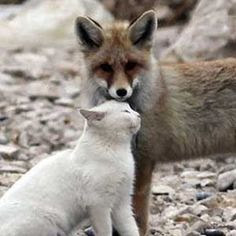
A History of Urban Foxes in LondonUrban foxes are nothing new, but the high numbers are exceptional. But believe it or not, many of these first foxes were deliberately imported into London from Scotland or Wales. This was because in Victorian times there was a ready market for the sale of foxes to supply the hunt.
If a wealthy landowner’s estate was low on fox numbers, which made the foxhunt unsatisfactory, then a trip to London was the answer. Live foxes could be purchased in bulk at Leadenhall Market, transported to your estate and then released.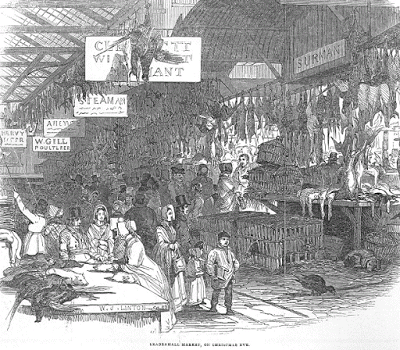 Victorian Leadenhall Market
Victorian Leadenhall Market
A Most Unfortunate FoxOne exceptionally unlucky fox had an extremely traumatic life. He was sold, released, hunted, and resold, not once, not twice, but three times – and only met his death by the hunt on the fourth occasion. The fox was identified by a slit ear and holes in the other ear which marked him out as unique. He was repeatedly bought by the Duke of Grafton, but on learning of this remarkable tale there were protests.
It was argued in the press that the fox had earnt the right to be hunted no more. “[His continued survival]…ought to have entitled him to the privilege formerly granted to a stag who had been fortunate enough to escape from his royal pursuers.”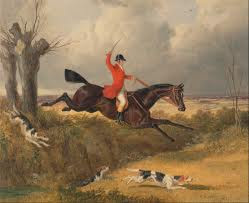
Truly Wild FoxesThe population of truly wild foxes in London started to rise with the advent of the railways. The foxes followed the path cleared by the rail tracks and the burgeoning road network, and found rich pickings in the urban environment.
What constantly amazes me is that many people who put food out for foxes are either own dogs or are dog lovers. Of course I’m a huge animal lover and have nothing personal against foxes. However, feeding the urban fox population is a huge mistake because it encourages them to breed.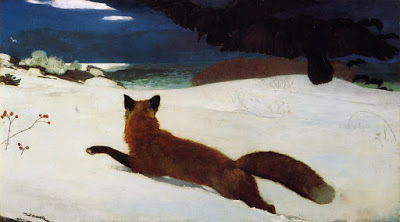
The Deadly Threat of LungwormA larger fox population means a greater reservoir of hosts for the deadly parasite, lungworm. This is a fox parasite, and when it infects dogs can cause death. If lungworm goes untreated the dog develops vague symptoms such as a cough or tummy upset. But far worse than this is that lungworm interferes with blood clotting.
Seemingly healthy dogs can die in the space of 24 hours from a minor cut which refuses to stop bleeding. Or some dogs bleed internally and collapse, much to the distress of their owner (who co-incidentally may have been attracting foxes into the garden with food).
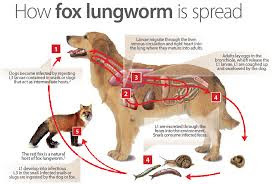
Avoiding LungwormIf you are a dog owner then don’t encourage foxes. In addition, to protect your pet take the following steps:
· Your vet can recommend a product licensed to prevent lungworm. Use it regularly· Don’t leave toys or water bowls outside. This is because slugs and snails act as an intermediate host and have larvae in their slime. Dogs can become infected by contact with the snail trail· De-slug your garden· Don’t encourage foxes

A History of Urban Foxes in LondonUrban foxes are nothing new, but the high numbers are exceptional. But believe it or not, many of these first foxes were deliberately imported into London from Scotland or Wales. This was because in Victorian times there was a ready market for the sale of foxes to supply the hunt.
If a wealthy landowner’s estate was low on fox numbers, which made the foxhunt unsatisfactory, then a trip to London was the answer. Live foxes could be purchased in bulk at Leadenhall Market, transported to your estate and then released.
 Victorian Leadenhall Market
Victorian Leadenhall MarketA Most Unfortunate FoxOne exceptionally unlucky fox had an extremely traumatic life. He was sold, released, hunted, and resold, not once, not twice, but three times – and only met his death by the hunt on the fourth occasion. The fox was identified by a slit ear and holes in the other ear which marked him out as unique. He was repeatedly bought by the Duke of Grafton, but on learning of this remarkable tale there were protests.
It was argued in the press that the fox had earnt the right to be hunted no more. “[His continued survival]…ought to have entitled him to the privilege formerly granted to a stag who had been fortunate enough to escape from his royal pursuers.”

Truly Wild FoxesThe population of truly wild foxes in London started to rise with the advent of the railways. The foxes followed the path cleared by the rail tracks and the burgeoning road network, and found rich pickings in the urban environment.
What constantly amazes me is that many people who put food out for foxes are either own dogs or are dog lovers. Of course I’m a huge animal lover and have nothing personal against foxes. However, feeding the urban fox population is a huge mistake because it encourages them to breed.

The Deadly Threat of LungwormA larger fox population means a greater reservoir of hosts for the deadly parasite, lungworm. This is a fox parasite, and when it infects dogs can cause death. If lungworm goes untreated the dog develops vague symptoms such as a cough or tummy upset. But far worse than this is that lungworm interferes with blood clotting.
Seemingly healthy dogs can die in the space of 24 hours from a minor cut which refuses to stop bleeding. Or some dogs bleed internally and collapse, much to the distress of their owner (who co-incidentally may have been attracting foxes into the garden with food).

Avoiding LungwormIf you are a dog owner then don’t encourage foxes. In addition, to protect your pet take the following steps:
· Your vet can recommend a product licensed to prevent lungworm. Use it regularly· Don’t leave toys or water bowls outside. This is because slugs and snails act as an intermediate host and have larvae in their slime. Dogs can become infected by contact with the snail trail· De-slug your garden· Don’t encourage foxes
Published on August 23, 2015 12:10
August 9, 2015
Medieval LOL Cats: Why the Victorians may not have invented cat memes after all
Last week we looked at how the Victorians were way ahead of the internet, and did in fact invent the LOLCat (The 19th Century Origins of theCat Meme). But is that correct? Delving deeper into the wonderful world of feline imagery I find funny images of cats that predate photography and date back to medieval times.
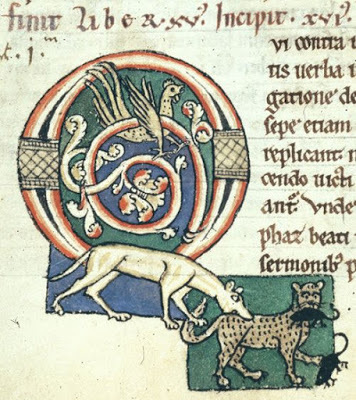
The above shows an illuminated letter “O” taken from a German document dating back to the late 12th century. It shows a dog catching a cat catching a mouse. An allegory perhaps on the nature the predator becoming prey.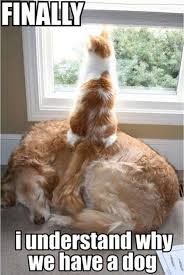
Whereas in the modern meme it is the cat who has at last assumed their rightful place (comment if you disagree!) as the superior species. It only took from nearly 900 years of meme development for this to truth to be realized.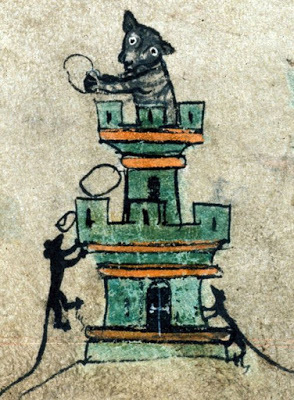
This image is rich with comedic irony, as the cat is assailed by his dinner, the mouse. This cat in his castle dates to around 1320 and a Book of Hours, from London, England.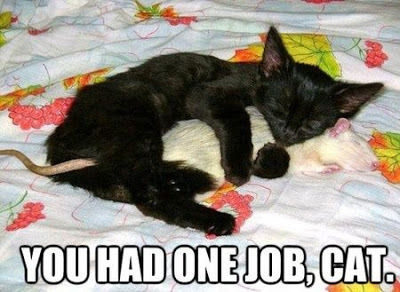
Whereas the modern way is reflect on the fickle nature of felines and how their role protecting crops from vermin has evolved over the centuries (or something like that.)
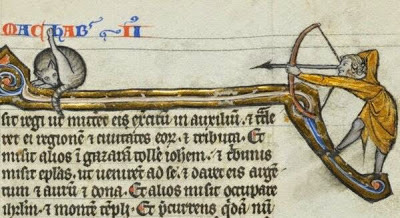
Then of course we had this marginalia drawing, which went viral on the internet under the title “Cedric is not a cat lover”. A classic meme if ever there was one.
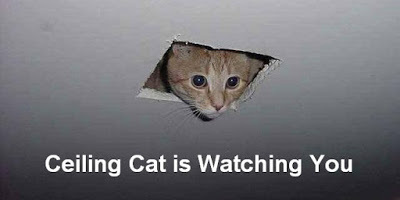
And of course, cats have never forgotten it. Over the intervening centuries they evolved into the ceiling cat to protect their furry brethren by keeping man under constant surveillance at all times.
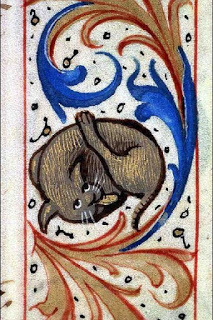
Last but not least there is a profusion of comedic drawings of cats washing their nether regions. Quite why monks skilled in calligraphy and illumination should find this amusing is not known.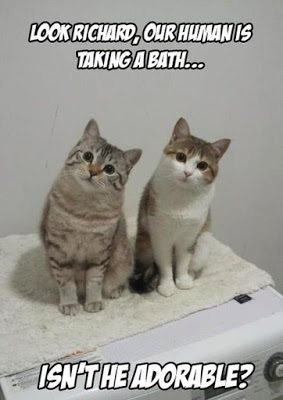
However, the final word goes to our LOLCats who have mastered the art of reflecting ridiculous behavior back to the originator.[Post inspired by a post on the Medieval Manuscripts blog: lol cats ofthe Middle Ages ]

The above shows an illuminated letter “O” taken from a German document dating back to the late 12th century. It shows a dog catching a cat catching a mouse. An allegory perhaps on the nature the predator becoming prey.

Whereas in the modern meme it is the cat who has at last assumed their rightful place (comment if you disagree!) as the superior species. It only took from nearly 900 years of meme development for this to truth to be realized.

This image is rich with comedic irony, as the cat is assailed by his dinner, the mouse. This cat in his castle dates to around 1320 and a Book of Hours, from London, England.

Whereas the modern way is reflect on the fickle nature of felines and how their role protecting crops from vermin has evolved over the centuries (or something like that.)

Then of course we had this marginalia drawing, which went viral on the internet under the title “Cedric is not a cat lover”. A classic meme if ever there was one.

And of course, cats have never forgotten it. Over the intervening centuries they evolved into the ceiling cat to protect their furry brethren by keeping man under constant surveillance at all times.

Last but not least there is a profusion of comedic drawings of cats washing their nether regions. Quite why monks skilled in calligraphy and illumination should find this amusing is not known.

However, the final word goes to our LOLCats who have mastered the art of reflecting ridiculous behavior back to the originator.[Post inspired by a post on the Medieval Manuscripts blog: lol cats ofthe Middle Ages ]
Published on August 09, 2015 11:31
August 2, 2015
The 19th Century Origins of the Cat Meme
Love cat memes?
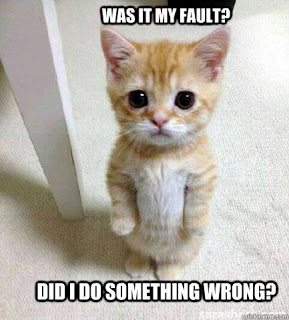
Of course you do. After all it’s why the internet was invented. But when do you think the cat meme was first invented?
It may surprise you to know that it was the Victorian’s who came up with the innovation of cute cats pics with a funny caption.
Harry Pointer
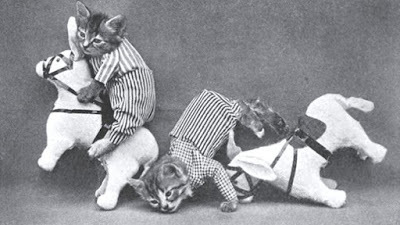
Harry Pointer is arguably the earliest master of the cat meme. Englishman Pointer was born in 1822 and an early adopter of kitten photography. He started out taking naturalistic photographs of cats, until in the 1870s he realised there was a niche to be had in pictures of kittens in ludicrous poses. He wasn’t wrong.
Pointer completed around 200 early memes, which he called is “Brighton Cats”. However, he went on to hand the baton another later photographer, Harry Whittier Frees.
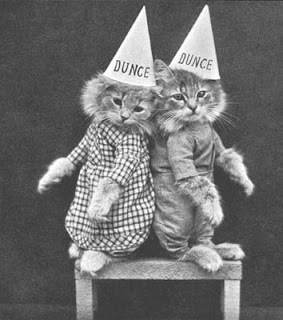
Harry Whittier Frees
The term “LOLCats” was coined in 2006, but as this picture shows the first LOLcats (cute pictures of cats with a humours caption) appeared in 1914. Harry Whittier Frees specialized in taking funny photos of cats. An American born in 1873 he made a living selling his images as postcards of live animals dressed in human clothing. Posing living animals was a new idea, because previously similar photographs had been of stuffed animals.
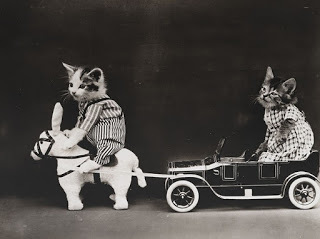
Henriette Ronner-Knip
Born in Amsterdam in 1821, Henriette made her reputation painting cutesy pictures of animals, especially cats. She had a special studio space with a glass front so that she could watch the kittens at play without disturbing them, in order to choose the sweetest poses. Although not a meme as such, there had a similar effect on the viewer, of making them go “Ahhh” and want to share the image with their friends.
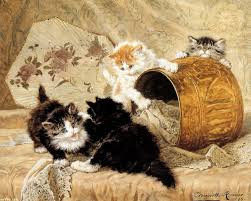
Cornelius Raaphorst
Another person of Dutch origin Cornelius was born in 1875 and maxed out on paintings of cute kittens. Typical titles included “Kittens at Play” and "The Birdcage", the subject of which is self-explanatory.
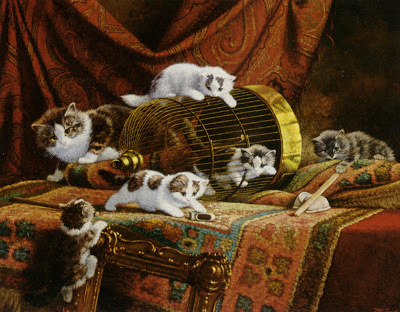
Louis Wain
Another supremo of LOLCats was Louis Wain. His paintings of anthropomorphic cats were hugely popular. His amazing pictures adorned postcards, greetings cards, calendars and posters and were the late Victorian equivalent of Wallace and Gromit.
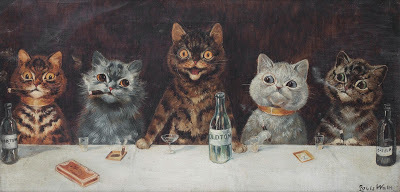
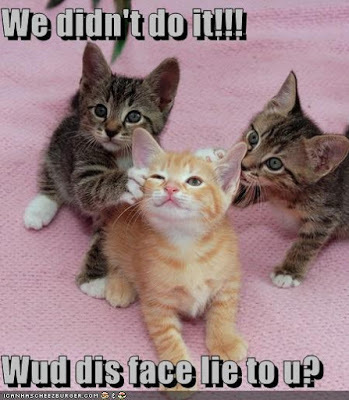

Of course you do. After all it’s why the internet was invented. But when do you think the cat meme was first invented?
It may surprise you to know that it was the Victorian’s who came up with the innovation of cute cats pics with a funny caption.
Harry Pointer

Harry Pointer is arguably the earliest master of the cat meme. Englishman Pointer was born in 1822 and an early adopter of kitten photography. He started out taking naturalistic photographs of cats, until in the 1870s he realised there was a niche to be had in pictures of kittens in ludicrous poses. He wasn’t wrong.
Pointer completed around 200 early memes, which he called is “Brighton Cats”. However, he went on to hand the baton another later photographer, Harry Whittier Frees.

Harry Whittier Frees
The term “LOLCats” was coined in 2006, but as this picture shows the first LOLcats (cute pictures of cats with a humours caption) appeared in 1914. Harry Whittier Frees specialized in taking funny photos of cats. An American born in 1873 he made a living selling his images as postcards of live animals dressed in human clothing. Posing living animals was a new idea, because previously similar photographs had been of stuffed animals.

Henriette Ronner-Knip
Born in Amsterdam in 1821, Henriette made her reputation painting cutesy pictures of animals, especially cats. She had a special studio space with a glass front so that she could watch the kittens at play without disturbing them, in order to choose the sweetest poses. Although not a meme as such, there had a similar effect on the viewer, of making them go “Ahhh” and want to share the image with their friends.

Cornelius Raaphorst
Another person of Dutch origin Cornelius was born in 1875 and maxed out on paintings of cute kittens. Typical titles included “Kittens at Play” and "The Birdcage", the subject of which is self-explanatory.

Louis Wain
Another supremo of LOLCats was Louis Wain. His paintings of anthropomorphic cats were hugely popular. His amazing pictures adorned postcards, greetings cards, calendars and posters and were the late Victorian equivalent of Wallace and Gromit.


Published on August 02, 2015 14:01
July 26, 2015
Cats of the Tower of London: Sir Henry Wyatt and the Caterer Cat
In this our second post about cats and the Tower of London, we look at Sir Henry Wyatt and the “Caterer” cat.
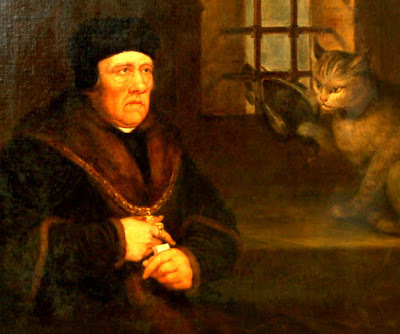 Sir Henry Wyatt in later life (he was in his 20s when imprisoned)
Sir Henry Wyatt in later life (he was in his 20s when imprisoned)
Note the cat dragging a bird through the window
Born in 1460, Sir Henry Wyatt was a Yorkshireman and attended Eton with Henry Tudor. Unfortunately for Wyatt at the time of our story, it was not Henry Tudor on the throne but Richard III, and the later was distinctly twitchy about anyone who might support the Tudor line of accession.
Richard decided to limit any damage Wyatt might be tempted to do by imprisoning him in the Tower of London. Just to make sure he felt completely unwelcome, Wyatt was tortured, and kept in squalid conditions sleeping on straw on a stone floor and with his clothes in rags. Given very little food, he was also starving. The Tower of London
The Tower of London
“He [Wyatt] was imprisoned often, once in a cold and narrow Tower, where he had neither bed to oie on, nor clothes sufficient to warm him, nor meat for his mouth.”But at this his most desperate hour an unlikely angel came to him. This angel had four-legs and a furry coat, and was actually a cat.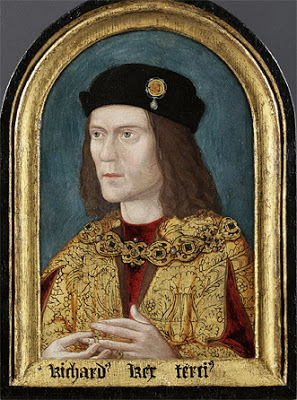 Earliest known surviving portrait of
Earliest known surviving portrait of
Richard III
“A cat came into the dungeon with him, and, as it were, offered herself unto him. He was glad of her, laid her in his bosom to warm him, and by making much of her won her love. After that she would come at diverse time, and when she could get him one, bring him a pigeon.”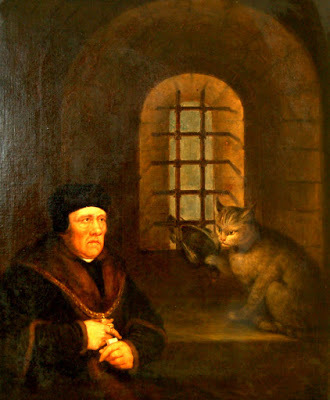
The pigeon was then duly cooked by a friendly jailor, providing much needed nourishment. Indeed, such was the cat’s provision for hm that she became nicknamed as “the caterer cat”.
In later years when Wyatt was free, and Henry Tudor on the throne, Wyatt was notorious for having a fondness for cats. Papers belonging to the Wyatt family, written in 1727, remark how: “Sir Henry always made much of a cat, and was always to be found with a cat beside him.”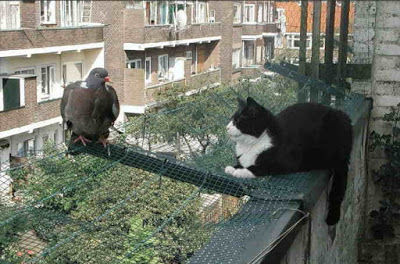
 Sir Henry Wyatt in later life (he was in his 20s when imprisoned)
Sir Henry Wyatt in later life (he was in his 20s when imprisoned)Note the cat dragging a bird through the window
Born in 1460, Sir Henry Wyatt was a Yorkshireman and attended Eton with Henry Tudor. Unfortunately for Wyatt at the time of our story, it was not Henry Tudor on the throne but Richard III, and the later was distinctly twitchy about anyone who might support the Tudor line of accession.
Richard decided to limit any damage Wyatt might be tempted to do by imprisoning him in the Tower of London. Just to make sure he felt completely unwelcome, Wyatt was tortured, and kept in squalid conditions sleeping on straw on a stone floor and with his clothes in rags. Given very little food, he was also starving.
 The Tower of London
The Tower of London“He [Wyatt] was imprisoned often, once in a cold and narrow Tower, where he had neither bed to oie on, nor clothes sufficient to warm him, nor meat for his mouth.”But at this his most desperate hour an unlikely angel came to him. This angel had four-legs and a furry coat, and was actually a cat.
 Earliest known surviving portrait of
Earliest known surviving portrait ofRichard III
“A cat came into the dungeon with him, and, as it were, offered herself unto him. He was glad of her, laid her in his bosom to warm him, and by making much of her won her love. After that she would come at diverse time, and when she could get him one, bring him a pigeon.”

The pigeon was then duly cooked by a friendly jailor, providing much needed nourishment. Indeed, such was the cat’s provision for hm that she became nicknamed as “the caterer cat”.
In later years when Wyatt was free, and Henry Tudor on the throne, Wyatt was notorious for having a fondness for cats. Papers belonging to the Wyatt family, written in 1727, remark how: “Sir Henry always made much of a cat, and was always to be found with a cat beside him.”

Published on July 26, 2015 12:38
July 19, 2015
Cats of the Tower of London: Trixie and the Earl of Southampton
Do you love cats and history? Then this post is for you.
Our history concerns the gentleman in the portrait with a fine head of hair. He is no lesser person than a Tudor aristocrat, Henry Wriothesley, the third Earl of Southampton. This dashing looking fellow was notorious for a number of reasons, not least being that he was Shakespeare’s patron and rumoured to have romantic attachments to the great bard. But our tale concerns his political machinations, and the inspiration behind the portrait. So look closely and what do you see?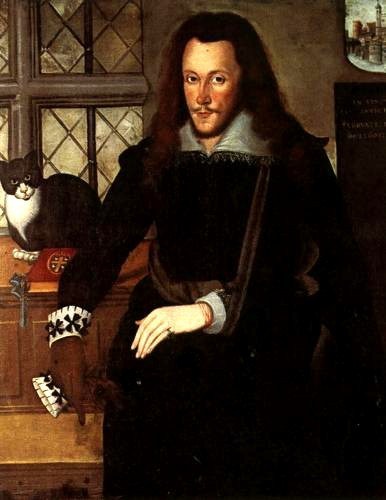
A well-dressed nobleman with bows on his cuffs. A wood-panelled chamber. A black and white cat perched on a window ledge. But look again. Did you spot behind Wriothesley’s left shoulder the painting of the Tower of London?
Wriothesley did indeed spend time imprisoned in the Tower. He chose his friends poorly, and fell in with a group of noblemen who in 1601 rebelled against the elderly Queen Elizabeth I.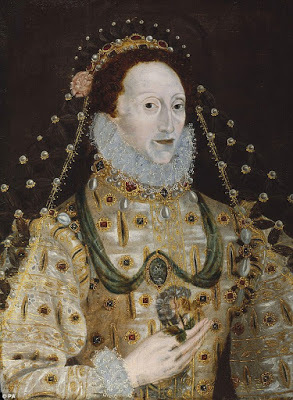 Queen Elizabeth I
Queen Elizabeth I
The aim of their insurrection was to force the Queen to name, her cousin’s son, James VI of Scotland, as her heir. They feared if she did not, there would be civil war when the Queen died. However Elizabeth believed naming a successor would number her own days – after all she had ordered the execution of James’ mother, Mary Queen of Scots.
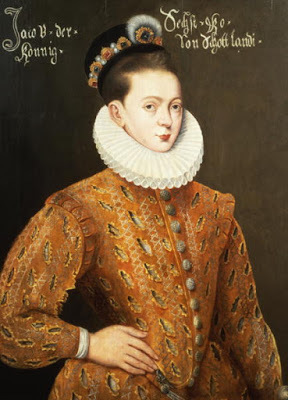 James VI of Scotland,
James VI of Scotland,
in younger life
The rebels were led the Earl of Sussex, Sir Robert Devereux, and the Earl of Southampton. But their attempts to rouse London’s inhabitants one Sunday failed miserably. They had fatally underestimated the lethargy thought prosperity induced. They were captured and Essex executed.
However, Wriothesley was left to think on the folly of his actions whilst incarcerated in the Tower. His mother and wife pleaded with Elizabeth for clemency and to not execute him. For her part Elizabeth had lost her appetite for blood and agreed to let him keep his life but languish in the Tower of London at her pleasure.
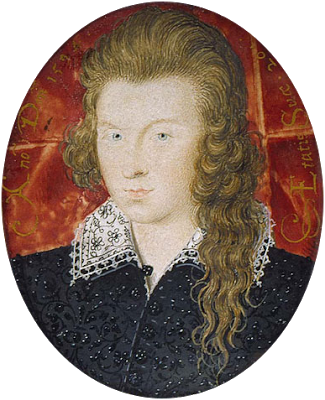 Wriothesley in 1594
Wriothesley in 1594
And this is where the cat comes in. Apparently, bereft of company and comfort, Wriothesley was pretty miserable and had an unhappy time of his imprisonment. Legend has it that Wriothesley missed his favourite cat, Trixie. In turn, she missed her master and contrived break into the prison by climbing down the chimney.“After he[Wriothesley) had been confined there[The Tower of London] a small time, he was surprised by a visit from his favourite cat, which had found its way to the Tower.”Thomas Pennant, 1793 “Some Account of London”.
However, a less romantic explanation exists as to how Trixie came to be there. It was muttered that Wriothesley’s wife brought the cat along on a visit.
And finally, the portrait is hugely interesting in its own right. It was painted in a rush shortly after the death of Queen Elizabeth I in March, 1603. The painting was completed in just six days and nights, and then rushed to Edinburgh for James to see. It is rich with code and appealed for the new King of England to set him free.
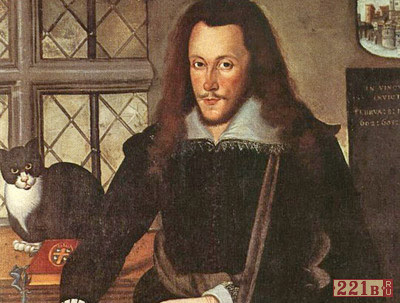
The code hidden within the picture includes: · He is wearing black, a sign of mourning for the Earl of Essex (and a hero to James). · A pane of glass is smashed, a reminder of the violent nature of Essex’s death.· His hair is shown loose around his shoulders, much like a brides – as if inviting James to become his sovereign lord. · The exact date of the start of his sentence is recorded on the portrait, but the date of release is left open, as if inviting James to set him free.
The new king of England was mightily impressed:
“The great and honest affection borne to us by the Earl of Southampton…we have written to the Lieutenant of the Tower to deliver him out of prison presently.” James VI of Scotland, James I of England
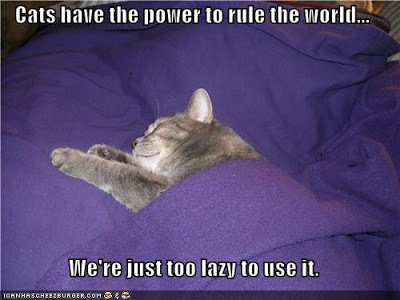
Our history concerns the gentleman in the portrait with a fine head of hair. He is no lesser person than a Tudor aristocrat, Henry Wriothesley, the third Earl of Southampton. This dashing looking fellow was notorious for a number of reasons, not least being that he was Shakespeare’s patron and rumoured to have romantic attachments to the great bard. But our tale concerns his political machinations, and the inspiration behind the portrait. So look closely and what do you see?

A well-dressed nobleman with bows on his cuffs. A wood-panelled chamber. A black and white cat perched on a window ledge. But look again. Did you spot behind Wriothesley’s left shoulder the painting of the Tower of London?
Wriothesley did indeed spend time imprisoned in the Tower. He chose his friends poorly, and fell in with a group of noblemen who in 1601 rebelled against the elderly Queen Elizabeth I.
 Queen Elizabeth I
Queen Elizabeth IThe aim of their insurrection was to force the Queen to name, her cousin’s son, James VI of Scotland, as her heir. They feared if she did not, there would be civil war when the Queen died. However Elizabeth believed naming a successor would number her own days – after all she had ordered the execution of James’ mother, Mary Queen of Scots.
 James VI of Scotland,
James VI of Scotland,in younger life
The rebels were led the Earl of Sussex, Sir Robert Devereux, and the Earl of Southampton. But their attempts to rouse London’s inhabitants one Sunday failed miserably. They had fatally underestimated the lethargy thought prosperity induced. They were captured and Essex executed.
However, Wriothesley was left to think on the folly of his actions whilst incarcerated in the Tower. His mother and wife pleaded with Elizabeth for clemency and to not execute him. For her part Elizabeth had lost her appetite for blood and agreed to let him keep his life but languish in the Tower of London at her pleasure.
 Wriothesley in 1594
Wriothesley in 1594And this is where the cat comes in. Apparently, bereft of company and comfort, Wriothesley was pretty miserable and had an unhappy time of his imprisonment. Legend has it that Wriothesley missed his favourite cat, Trixie. In turn, she missed her master and contrived break into the prison by climbing down the chimney.“After he[Wriothesley) had been confined there[The Tower of London] a small time, he was surprised by a visit from his favourite cat, which had found its way to the Tower.”Thomas Pennant, 1793 “Some Account of London”.
However, a less romantic explanation exists as to how Trixie came to be there. It was muttered that Wriothesley’s wife brought the cat along on a visit.
And finally, the portrait is hugely interesting in its own right. It was painted in a rush shortly after the death of Queen Elizabeth I in March, 1603. The painting was completed in just six days and nights, and then rushed to Edinburgh for James to see. It is rich with code and appealed for the new King of England to set him free.

The code hidden within the picture includes: · He is wearing black, a sign of mourning for the Earl of Essex (and a hero to James). · A pane of glass is smashed, a reminder of the violent nature of Essex’s death.· His hair is shown loose around his shoulders, much like a brides – as if inviting James to become his sovereign lord. · The exact date of the start of his sentence is recorded on the portrait, but the date of release is left open, as if inviting James to set him free.
The new king of England was mightily impressed:
“The great and honest affection borne to us by the Earl of Southampton…we have written to the Lieutenant of the Tower to deliver him out of prison presently.” James VI of Scotland, James I of England

Published on July 19, 2015 11:22
'Familiar Felines.'
Following on from last weeks Halloween posting, today's blog post looks at the unwanted image of cats as the witches familiar - from the Norse Goddess Freya to lonely women in the middle ages.
The full Following on from last weeks Halloween posting, today's blog post looks at the unwanted image of cats as the witches familiar - from the Norse Goddess Freya to lonely women in the middle ages.
The full post can found at:
http://graceelliot-author.blogspot.com
...more
The full Following on from last weeks Halloween posting, today's blog post looks at the unwanted image of cats as the witches familiar - from the Norse Goddess Freya to lonely women in the middle ages.
The full post can found at:
http://graceelliot-author.blogspot.com
...more
- Grace Elliot's profile
- 156 followers



